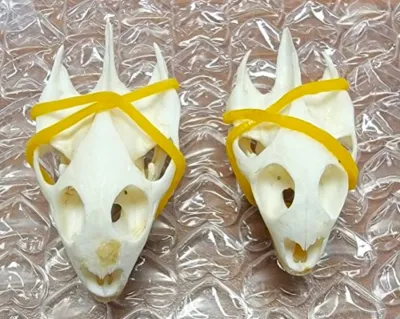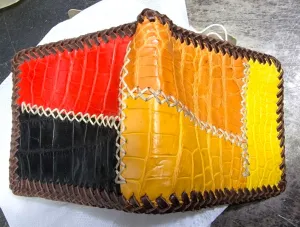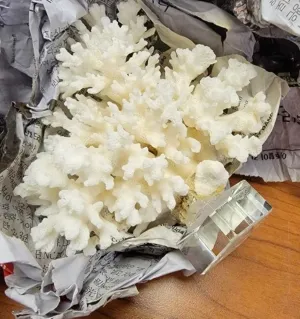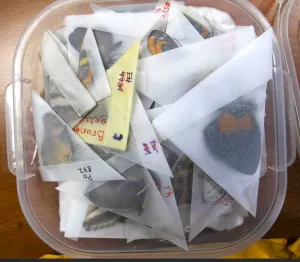Arriving in Air Mail Packages the seized items violated U.S. Fish and Wildlife and Endangered Species Regulations
LOS ANGELES—Since the beginning of 2024 fiscal year (October 1, 2023) to date, U.S. Customs and Border Protection CBP officers and agriculture specialists assigned to the Los Angeles International Airport (LAX) International Mail Facility (IMF) in coordination with U.S. Fish and Wildlife Service (USFWS) officials detained 4,227 animal and plant products for violating wildlife laws and regulations and international endangered species conventions.
Among the detained products, crocodile skulls, jerky, belts, wallets, taxidermy baby crocodiles, turtle skulls, skins, kangaroo meat, tails, ears, elephant toenails, exotic butterflies, peacock feathers, seashells, coral, sea cucumbers, shark cartilages, sand sea lion oil gel caps.
The seized products arrived in individual packages via air mail from Singapore, Vietnam, Australia, China, Thailand, U.K., Mexico, and Peru. The contraband packages were heading to addresses all over the United States.
“CBP agriculture specialists are the frontline in the fight against the global trafficking of protected wildlife and plant species,” said Cheryl M. Davies, CBP Director of Field Operations in Los Angeles. “Every single day, they bring their natural sciences knowledge, expertise and unique skills to identify, intercept and seized suspected shipments.”
“The USFWS Office of Law Enforcement’s Wildlife Inspection Program meticulously inspects shipments of known and suspected wildlife to facilitate its legal trade and interdict illegal shipments of wildlife before they enter or leave the country,” said Edward Grace, Assistant Director of the USFWS Office of Law Enforcement. “Their diligent work safeguards protected species of wildlife and upholds laws and regulations protecting against the unlawful exploitation of nature’s valuable resources.”
The USFWS Office of Law Enforcement regulates all international movement of wildlife in, out and through the United States in order to conserve, protect and enhance fish, wildlife, and plants and their habitats for the continuing benefit of the American people.
“Illegal wildlife trafficking is one of the most profitable natural resource crimes,” said Andrew H. Douglas, CBP Port Director of Los Angeles International Airport. “It encompasses the harvesting and selling of wildlife, and wildlife products, to be used as medicine, fashion, food, or pets sold to consumers.”
Tips for Travelers
Going abroad? Think twice about the souvenirs you buy.
You’ll find many wildlife and plant products for sale around the world. As an international traveler, you can support conservation worldwide by asking questions and learning the facts before you buy any wildlife or plant product.
Just because you find an item for sale does not mean it is legal to import. Some of these products may be made from illegally taken animals or plants and may not be exported or imported. Others may require permits before you can bring them home to the United States. By making informed choices, you can avoid losing your souvenir or paying a fine.
Most countries protect their native animals and plants under national laws and through the Convention on International Trade in Endangered Species of Wild Fauna and Flora (CITES). Signed by more than 180 nations including the United States, this treaty supports sustainable trade in wildlife and plants while protecting species at risk.
In addition to international agreements, U.S. laws provide even stronger protections for such animals as marine mammals, elephants, spotted cats, sea turtles, and wild birds. If the country you are visiting bans the sale or export of a species, you cannot legally import it here.
What You Need to Know
Before you go shopping overseas, make sure that the country you’re visiting allows the export of its native species or other wildlife that you buy or acquire there. Many nations now prohibit or require permits for trade in wildlife and plants.
Remember that resource protection laws and treaties not only cover live animals and plants, but also mounted specimens, foods, parts, and products made from or decorated with fur, hide, skin, feathers, scales, shell, antlers, horns, teeth, claws, or bones.
The legality of a wildlife or plant souvenir may depend on both the species involved and the country where you bought it. Examples include products made from pangolin (an Asian anteater); caiman and crocodilian leathers; and mounted butterflies, moths, and insects.
If you are importing a bird or any other live animal, wildlife food products, or live plants, contact U.S. agriculture officials before you return to the United States. U.S. laws and regulations generally prohibit the importation of bushmeat, regardless of the species involved.
If you have questions about wildlife purchases before you travel, check with a Service wildlife inspection office. When overseas, contact local resource protection agencies and /or the country’s CITES Management Authority. For permit information, visit the Service’s permits website.







